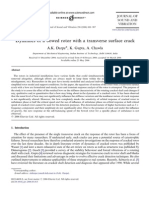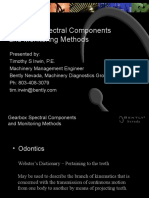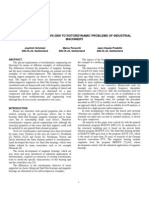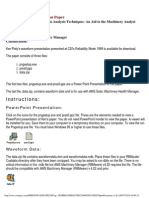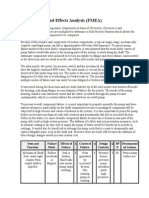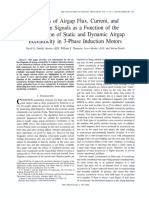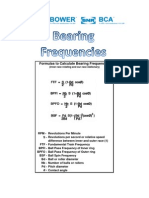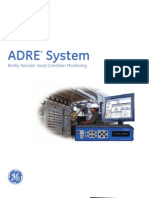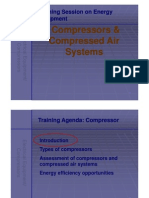Resonance - : A Condition Where The Natural Freq. of A Part Matches With Exciting Freq. and Creates Large Vibrations
Resonance - : A Condition Where The Natural Freq. of A Part Matches With Exciting Freq. and Creates Large Vibrations
Uploaded by
rashm006ranjanCopyright:
Available Formats
Resonance - : A Condition Where The Natural Freq. of A Part Matches With Exciting Freq. and Creates Large Vibrations
Resonance - : A Condition Where The Natural Freq. of A Part Matches With Exciting Freq. and Creates Large Vibrations
Uploaded by
rashm006ranjanOriginal Description:
Original Title
Copyright
Available Formats
Share this document
Did you find this document useful?
Is this content inappropriate?
Copyright:
Available Formats
Resonance - : A Condition Where The Natural Freq. of A Part Matches With Exciting Freq. and Creates Large Vibrations
Resonance - : A Condition Where The Natural Freq. of A Part Matches With Exciting Freq. and Creates Large Vibrations
Uploaded by
rashm006ranjanCopyright:
Available Formats
Resonance
A condition where the natural freq. Of a part matches with exciting freq. and creates large vibrations
Can be confirmed by changing ( increasing or decreasing ) the rotor speed, as the natural frequencies do not change with speed. Phase shift of 90 deg. at resonance and nearly 180 deg. after crossing it, will be observed.
RESONANCE
Every machine element has a natural frequency(s) based on mass and stiffness Resonance occurs when a forcing frequency coincides with a one of these natural frequencies
2
VIBRATION DUE TO RESONANCE
Every object, including every element or part of a machine, has a natural frequency or a frequency at which it likes to vibrate Determined by the machines mass and stiffness Does not cause vibration but serves as a mechanical amplifier (10x-100x) Resonance is a very common cause of excessive vibration because: Machines consist of many individual elements Stiffness of each machine component differs in all directions, causing several natural frequencies
3
Identifying and Correcting Resonance
Vibration will be Highly Directional Changing the Exciting Forcing Frequency Change the mass or stiffness of the suspected resonant machine component Perform a Bump Test
Bump Test Results Can Confirm Resonance Problems
Beat Vibration
Beat frequency is the result of two closely spaced frequency in and out of synchronization with one another. Wide band spectrum shows one peak pulsating up and down. Zoom spectrum shows two closely spaced frequency peaks ( difference of these two peaks is the beat frequency).
6
Beat Vibration
Beat frequency can be seen on a spectrum if low frequency response of the analyser and transducer is good enough to detect low frequency in the range of 5 100 CPM. Maximum vibration results when the time waveform of one frequency (F1) comes into phase with other frequency (F2). Minimum vibration occurs when these waveforms are out of phase by 180 deg.
7
Notes
You might also like
- Steam Ejector CalculationsDocument11 pagesSteam Ejector Calculationsrashm006ranjan100% (3)
- Machinery Lubrication I IIDocument12 pagesMachinery Lubrication I IIrashm006ranjan50% (2)
- Vibration Application DataDocument44 pagesVibration Application DataSaurabh PanditNo ratings yet
- EM76 - Modal Testing Part 1 - Introduction & Impact TestingDocument4 pagesEM76 - Modal Testing Part 1 - Introduction & Impact TestingChad HuntNo ratings yet
- Learning On VibrationDocument42 pagesLearning On VibrationAnkit Shakyawar100% (1)
- Back To Basics CMVA 4Document24 pagesBack To Basics CMVA 4Le Thanh HaiNo ratings yet
- Chapter 10Document63 pagesChapter 10Hosam Abd Elkhalek100% (2)
- Case Study Tuning Out Difficult Torsional Vibration ProblemDocument15 pagesCase Study Tuning Out Difficult Torsional Vibration Problempathakshashank100% (1)
- Signature AnalysisDocument49 pagesSignature AnalysisVirgilio50% (2)
- VibMatters-August 2016 PDFDocument6 pagesVibMatters-August 2016 PDFshakerNo ratings yet
- Low Frequency EvaluationDocument13 pagesLow Frequency EvaluationthrillerxNo ratings yet
- VibMatters September 2016 Final DownloadDocument7 pagesVibMatters September 2016 Final DownloadfazzlieNo ratings yet
- Dynamic of Bow RotorDocument20 pagesDynamic of Bow Rotormh1999100% (1)
- Malfunction Diagnosis: Shaft Crack: Charles T. HatchDocument12 pagesMalfunction Diagnosis: Shaft Crack: Charles T. Hatchlucas6medeiros-6No ratings yet
- Review of Rotor Balancing MethodsDocument16 pagesReview of Rotor Balancing MethodsFallo SusiloNo ratings yet
- Fan VibrationDocument6 pagesFan VibrationRavi Deshmukh100% (2)
- Vibration and Monitoring Terms GlossaryDocument12 pagesVibration and Monitoring Terms Glossaryyaniprasetyo12No ratings yet
- Basic Vibration Signal Processing For Bearing Fault DetectionDocument8 pagesBasic Vibration Signal Processing For Bearing Fault DetectionGuru PrakashNo ratings yet
- Machinery Fault DiagnosisDocument1 pageMachinery Fault DiagnosisVLD DiagnosticsNo ratings yet
- 3 Funda Randomvibration PDFDocument19 pages3 Funda Randomvibration PDFsteve4ovenNo ratings yet
- Gearbox Spectral Components Presentation V2Document29 pagesGearbox Spectral Components Presentation V2Asha Venkataram100% (1)
- 48 Case HistoryDocument17 pages48 Case HistorySamir Benabdallah100% (1)
- Lubrication Guide - Ultrasonic Condition-Based LubricationDocument7 pagesLubrication Guide - Ultrasonic Condition-Based LubricationLLNo ratings yet
- Case Study - Structural ResonanceDocument16 pagesCase Study - Structural ResonanceLong NguyenNo ratings yet
- Paper Rotor DynamicsDocument12 pagesPaper Rotor DynamicsTony HeNo ratings yet
- Troubleshooting Turbomachinery Using Startup and Coastdown Vibration DataDocument14 pagesTroubleshooting Turbomachinery Using Startup and Coastdown Vibration DataAhtsham AhmadNo ratings yet
- Peakvue Case History 2Document9 pagesPeakvue Case History 2ben_ramatlaNo ratings yet
- TOMAS UsersManualDocument94 pagesTOMAS UsersManualrodruren01No ratings yet
- Sensor Selection Guide: Common Vibration SensorsDocument9 pagesSensor Selection Guide: Common Vibration SensorsMajid TorabiNo ratings yet
- Advance VibrationDocument263 pagesAdvance VibrationSurya Pratap SinghNo ratings yet
- REDUCTION of The SKI SLOPE EFFECTDocument8 pagesREDUCTION of The SKI SLOPE EFFECTEnzo MarquesNo ratings yet
- Theory - Reciprocating Engine Vibration AnalysisDocument2 pagesTheory - Reciprocating Engine Vibration AnalysisJose Luis RattiaNo ratings yet
- Vibration Measurements On Slow Speed MachineryDocument9 pagesVibration Measurements On Slow Speed MachineryMohd Asiren Mohd SharifNo ratings yet
- Bumptest 180410120817Document13 pagesBumptest 180410120817Daniel Solares100% (1)
- How To Bump Test With MicrologDocument2 pagesHow To Bump Test With MicrologYuda SatriaNo ratings yet
- Time Waveform Analysis TechniquesDocument2 pagesTime Waveform Analysis TechniquesManel Montesinos50% (2)
- Failure Mode and Effects Analysis1Document6 pagesFailure Mode and Effects Analysis1VLASTARNo ratings yet
- Recent Advances in Vibrations AnalysisDocument248 pagesRecent Advances in Vibrations AnalysisJosé RamírezNo ratings yet
- Lubrication Identification Tag Best Practices and InnovationsDocument3 pagesLubrication Identification Tag Best Practices and InnovationsManuel LombarderoNo ratings yet
- Subsynchronous Oscillation Detection Using Microprocessor RelaysDocument12 pagesSubsynchronous Oscillation Detection Using Microprocessor RelaysjeffguitarNo ratings yet
- A I RS: David G. Dorrell, William ThomsonDocument11 pagesA I RS: David G. Dorrell, William ThomsonEng Bagaragaza RomualdNo ratings yet
- Innovative Control of Noise and Vibration of Industrial Equipments and MachinesDocument13 pagesInnovative Control of Noise and Vibration of Industrial Equipments and MachinesAJER JOURNALNo ratings yet
- System1 Plots - Machinery-Diagnostic - Part1Document16 pagesSystem1 Plots - Machinery-Diagnostic - Part1Thyagaraju PalisettyNo ratings yet
- NTN Bearing Bpfo&BpfiDocument61 pagesNTN Bearing Bpfo&BpfishantanusamajdarNo ratings yet
- Adre BrochureDocument12 pagesAdre BrochurenuesteNo ratings yet
- Analysis ExamplesDocument53 pagesAnalysis ExamplesAbdelrahman KassmNo ratings yet
- Spike Energy (Deteccion Temprana para Muy Altas Frecuencias) PDFDocument22 pagesSpike Energy (Deteccion Temprana para Muy Altas Frecuencias) PDFMarcos Manzano100% (2)
- Vibration SeverityDocument11 pagesVibration SeverityDr. R. SharmaNo ratings yet
- Vibration Key ChartsDocument12 pagesVibration Key Chartsgsaiprasath100% (1)
- Vibration-based Condition Monitoring: Industrial, Aerospace and Automotive ApplicationsFrom EverandVibration-based Condition Monitoring: Industrial, Aerospace and Automotive ApplicationsNo ratings yet
- Basic Vibration by Tong - EmailedDocument67 pagesBasic Vibration by Tong - EmailedTatdanai MekarpornNo ratings yet
- 9 Natural FrequencyDocument12 pages9 Natural FrequencyRais RijalNo ratings yet
- Module 4Document32 pagesModule 4ARJUN BEDI204005No ratings yet
- Condition MonitoringDocument52 pagesCondition MonitoringAbdullaHanèèfa100% (3)
- Basic Vibration Data CollectionDocument46 pagesBasic Vibration Data CollectionTatdanai MekarpornNo ratings yet
- Chapter1 IntroductiontoNVHDocument24 pagesChapter1 IntroductiontoNVHDuc NguyenNo ratings yet
- Vibration of Circular Plate: Experiment No. 6Document8 pagesVibration of Circular Plate: Experiment No. 6NILESH SABALENo ratings yet
- Mechanical Natural Frequency and Bump Testing PDFDocument22 pagesMechanical Natural Frequency and Bump Testing PDFalvaroinc04100% (2)
- Part I Vibration MeasurementsDocument33 pagesPart I Vibration Measurementswaleed yehiaNo ratings yet
- Basic Vibration AnalysisDocument43 pagesBasic Vibration Analysisdhaval_trivedi_3No ratings yet
- Dresser RandDocument71 pagesDresser RandLong Nguyen100% (3)
- Cat II Course PDFDocument153 pagesCat II Course PDFMohammad Zainullah Khan100% (4)
- 03 - Confined Space EntryDocument18 pages03 - Confined Space Entryrashm006ranjanNo ratings yet
- Earned Value Management (EVM)Document8 pagesEarned Value Management (EVM)rashm006ranjanNo ratings yet
- Earned Value Management (EVM)Document8 pagesEarned Value Management (EVM)rashm006ranjanNo ratings yet
- NCQC 2016 RaipurDocument8 pagesNCQC 2016 Raipurrashm006ranjanNo ratings yet
- Turbine Cooling TemperaturesDocument12 pagesTurbine Cooling Temperaturesrashm006ranjan0% (1)
- New Book Launch Schedule 36 Days: Planning Complete!Document1 pageNew Book Launch Schedule 36 Days: Planning Complete!rashm006ranjanNo ratings yet
- 3rd Floor Service Bldg. Intercom List 2nd Floor Service Bldg. Intercom ListDocument2 pages3rd Floor Service Bldg. Intercom List 2nd Floor Service Bldg. Intercom Listrashm006ranjanNo ratings yet
- Energy Audit For Electric MotorDocument4 pagesEnergy Audit For Electric Motorrashm006ranjanNo ratings yet
- Annemometer and ThermometerDocument1 pageAnnemometer and Thermometerrashm006ranjanNo ratings yet
- Simple FormattingDocument1 pageSimple Formattingrashm006ranjanNo ratings yet
- HyperGraph3D TutorialsDocument41 pagesHyperGraph3D Tutorialsrashm006ranjanNo ratings yet
- Loss Optimisation in BoilersDocument50 pagesLoss Optimisation in Boilersrashm006ranjanNo ratings yet
- 790Document5 pages790rashm006ranjanNo ratings yet
- Bevel & Hypoid Gears:: Measuring BacklashDocument3 pagesBevel & Hypoid Gears:: Measuring Backlashrashm006ranjan100% (1)
- Coal Mill Heat BalanceDocument2 pagesCoal Mill Heat Balancerashm006ranjanNo ratings yet
- SKF Dry Lubricated Bearings 11358 3 enDocument28 pagesSKF Dry Lubricated Bearings 11358 3 enrashm006ranjan100% (2)
- Compressor and Compressed Air SystemDocument34 pagesCompressor and Compressed Air Systemrashm006ranjanNo ratings yet
- Coal Mill Heat BalanceDocument2 pagesCoal Mill Heat Balancerashm006ranjanNo ratings yet
- The Condenser Performance Test and Thermal Performance Analysis of Variable Conditions in TQNPCDocument4 pagesThe Condenser Performance Test and Thermal Performance Analysis of Variable Conditions in TQNPCrashm006ranjanNo ratings yet
- National Institute of Technology CalicutDocument14 pagesNational Institute of Technology Calicutrashm006ranjanNo ratings yet
- Paper 2 - Set B Solutions: General InstructionsDocument14 pagesPaper 2 - Set B Solutions: General Instructionsrashm006ranjanNo ratings yet












